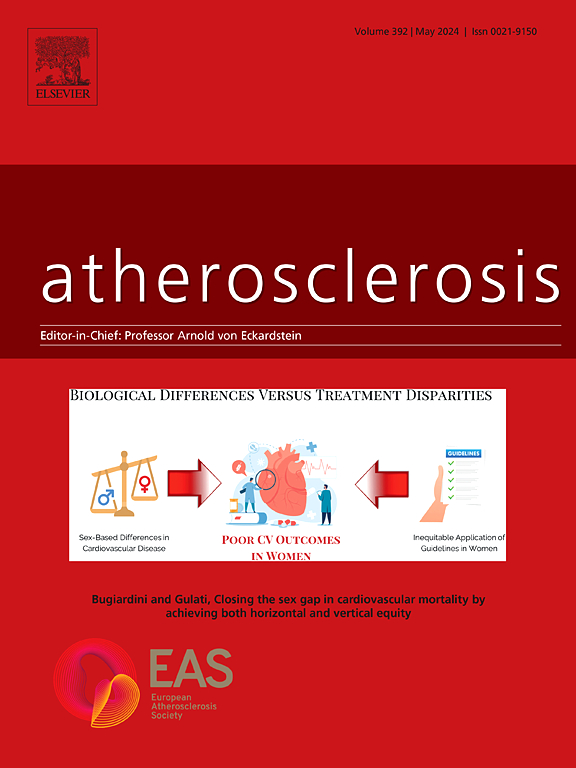血管生成素样蛋白抑制剂:治疗家族性高胆固醇血症和动脉粥样硬化性血脂异常的有希望的药物
IF 5.7
2区 医学
Q1 CARDIAC & CARDIOVASCULAR SYSTEMS
引用次数: 0
摘要
背景和目的本文综述了血管生成素样蛋白(ANGPTLs)在脂质代谢和动脉粥样硬化性心血管疾病(ASCVD)的流行病学中的生理功能,同时讨论了它们在治疗血脂异常方面的潜力。方法回顾当代有关ANGPTLs的文献。结果angptl由8种与血管生成素家族结构相似的分泌蛋白组成,是多种生理生化功能的关键调节因子。值得注意的是,ANGPTL3、ANGPTL4和ANGPTL8作为脂蛋白脂肪酶(LPL)的生理性抑制剂,在响应机体营养状况的脂蛋白和甘油三酯代谢中起着至关重要的作用。这些蛋白的缺乏与低血脂有关,其特征是所有脂质部分的减少,遗传学研究表明,ANGPTL3和ANGPTL4功能丧失变异的个体患ASCVD的风险降低。相反,ANGPTL3、ANGPTL4和ANGPTL8水平升高似乎会增加心血管疾病的风险。angptl在调节脂质代谢中的作用强调了它们在控制血脂异常和降低ASCVD风险的靶向治疗中的潜力,特别是在难以控制的血脂异常表型(如纯合子家族性高胆固醇血症和混合性血脂异常)患者中。结论ANGPTL抑制剂的开发为预防ASCVD提供了有效的策略。本文章由计算机程序翻译,如有差异,请以英文原文为准。

Angiopoietin-like protein inhibitors: Promising agents for the treatment of familial hypercholesterolemia and atherogenic dyslipidemia
Background and aims
This review examines the physiological functions of Angiopoietin-like proteins (ANGPTLs) in lipid metabolism and the epidemiology of atherosclerotic cardiovascular disease (ASCVD), while discussing their potential as therapies for dyslipidemias.
Methods
A review of contemporary literature on ANGPTLs was conducted.
Results
ANGPTLs comprise eight secreted proteins that share structural similarities with the angiopoietin family and serve as key regulators of various physiological and biochemical functions. Notably, ANGPTL3, ANGPTL4, and ANGPTL8 act as physiological inhibitors of lipoprotein lipase (LPL), playing a crucial role in lipoprotein and triglyceride metabolism in response to the body's nutritional status. A deficiency in these proteins is linked to hypolipidemia, characterized by a decrease in all lipid fractions, and genetic studies indicate a reduced risk of ASCVD in individuals with loss-of-function variants in ANGPTL3 and ANGPTL4. Conversely, elevated levels of ANGPTL3, ANGPTL4, and ANGPTL8 seem to increase the risk of cardiovascular disease. The role of ANGPTLs in regulating lipid metabolism underscores their potential in targeted therapies for managing dyslipidemias and lowering ASCVD risk, particularly in patients with difficult-to-control dyslipidemia phenotypes, such as homozygous Familial Hypercholesterolemia and mixed dyslipidemia.
Conclusions
The development of ANGPTL inhibitors could provide an effective strategy for preventing ASCVD.
求助全文
通过发布文献求助,成功后即可免费获取论文全文。
去求助
来源期刊

Atherosclerosis
医学-外周血管病
CiteScore
9.80
自引率
3.80%
发文量
1269
审稿时长
36 days
期刊介绍:
Atherosclerosis has an open access mirror journal Atherosclerosis: X, sharing the same aims and scope, editorial team, submission system and rigorous peer review.
Atherosclerosis brings together, from all sources, papers concerned with investigation on atherosclerosis, its risk factors and clinical manifestations. Atherosclerosis covers basic and translational, clinical and population research approaches to arterial and vascular biology and disease, as well as their risk factors including: disturbances of lipid and lipoprotein metabolism, diabetes and hypertension, thrombosis, and inflammation. The Editors are interested in original or review papers dealing with the pathogenesis, environmental, genetic and epigenetic basis, diagnosis or treatment of atherosclerosis and related diseases as well as their risk factors.
 求助内容:
求助内容: 应助结果提醒方式:
应助结果提醒方式:


